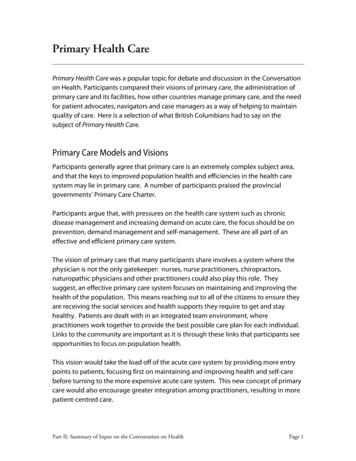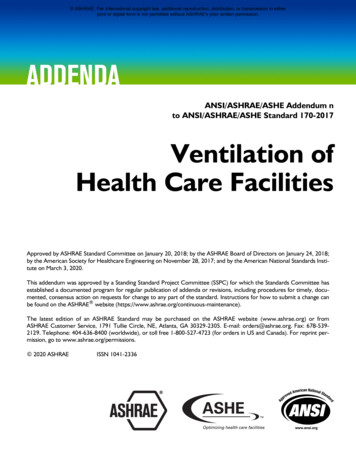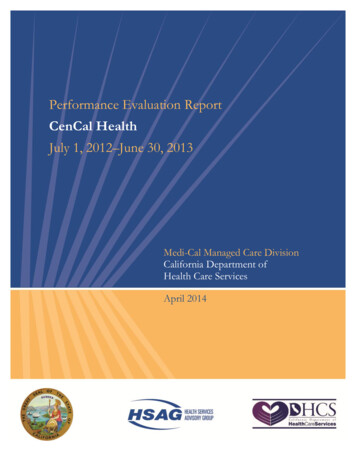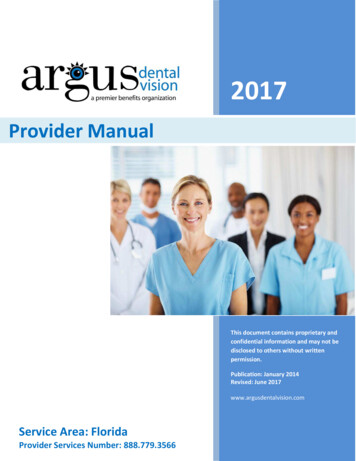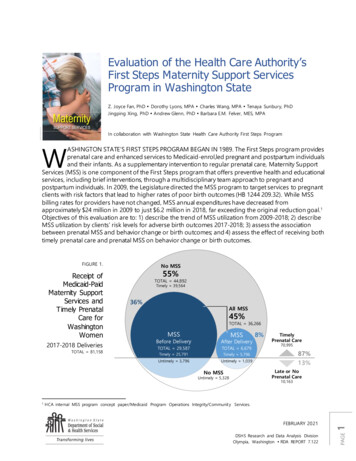
Transcription
Evaluation of the Health Care Authority’sFirst Steps Maternity Support ServicesProgram in Washington StateZ. Joyce Fan, PhD Dorothy Lyons, MPA Charles Wang, MPA Tenaya Sunbury, PhDJingping Xing, PhD Andrew Glenn, PhD Barbara E.M. Felver, MES, MPAIn collaboration with Washington State Health Care Authority First Steps ProgramWASHINGTON STATE’S FIRST STEPS PROGRAM BEGAN IN 1989. The First Steps program providesprenatal care and enhanced services to Medicaid-enrol,led pregnant and postpartum individualsand their infants. As a supplementary intervention to regular prenatal care, Maternity SupportServices (MSS) is one component of the First Steps program that offers preventive health and educationalservices, including brief interventions, through a multidisciplinary team approach to pregnant andpostpartum individuals. In 2009, the Legislature directed the MSS program to target services to pregnantclients with risk factors that lead to higher rates of poor birth outcomes (HB 1244 209.32). While MSSbilling rates for providers have not changed, MSS annual expenditures have decreased fromapproximately 24 million in 2009 to just 6.2 million in 2018, far exceeding the original reduction goal.1Objectives of this evaluation are to: 1) describe the trend of MSS utilization from 2009-2018; 2) describeMSS utilization by clients’ risk levels for adverse birth outcomes 2017-2018; 3) assess the associationbetween prenatal MSS and behavior change or birth outcomes; and 4) assess the effect of receiving bothtimely prenatal care and prenatal MSS on behavior change or birth outcomes. 81,158FIGURE 1.Receipt ofMedicaid-PaidMaternity SupportServices andTimely PrenatalCare forWashingtonWomen2017-2018 DeliveriesTOTAL 81,158No MSS55%TOTAL 44,892Timely 39,56436%All MSS45%TOTAL 36,266MSSMSSBefore DeliveryAfter DeliveryTOTAL 29,587TOTAL 6,679Timely 25,791Timely 5,796Untimely 3,796Untimely 1,039TimelyPrenatal Care70,99587%13%Late or NoPrenatal CareNo MSSUntimely 5,32810,163FEBRUARY 2021DSHS Research and Data Analysis DivisionOlympia, Washington RDA REPORT 7.1221HCA internal MSS program concept paper/Medicaid Program Operations Integrity/Community Services.PAGE18%
Key FindingsDuring 2009-2018, the MSS program served 229,744 women, representing 55% of all women withMedicaid-paid maternity care in Washington State. The legislatively mandated program changeresulted in a decrease of overall MSS utilization from 69% to 43%, and a reduction of average serviceunits from 21.4 to 10.2 from 2009 to 2018.Three out of five clients were identified through administrative records as having high level risksthat contribute to adverse birth outcomes and were eligible for the maximum level of MSS during2017-2018. Only 37% of the clients with high level risks received prenatal MSS, with an aver age 12service units, compared to 35% (average 11 units) and 38% (average 10 units) of clients with moderatelevel and low level or non-identified risks, respectively.Clients receiving prenatal MSS had improved health behaviors and birth outcomes during 20172018. After adjusting for demographics and clients’ risk factors during pregnancy, prenatal MSS wassignificantly associated with: 32% increase in smoking cessation during pregnancy (95% confidence interval (CI) 1.17-1.48), 12% reduction in preterm birth (95% CI 0.83-0.94), and 18% increase in breastfeeding (95% CI 1.18-1.25).Clients receiving both prenatal MSS and timely prenatal care during pregnancy had strongerimproved health behaviors and birth outcomes during 2017-2018. After adjusting for demographicsand clients’ risk factors during pregnancy, receiving both prenatal MSS and timely prenatal care (startedwithin 6 months of pregnancy) was significantly associated with: Two-fold increase in smoking cessation during pregnancy (OR 2.14, 95% CI 1.84-2.50), 22% reduction in preterm birth (95% CI 0.70-0.86), 17% reduction in low birthweight (95% CI 0.75-0.93), and Two-fold increase in initiation of breastfeeding (OR 2.18, 95% CI 2.00-2.38).Goals of MSS include:Increasing: Early access and ongoing use of prenatal and newborn care Screening for postpartum mood disorder Initiation and duration of breastfeeding Family planning knowledgeDecreasing: Maternal morbidity and mortality Low birth-weight babies Premature births Infant morbidity and mortality rates Health disparities The number of unintended pregnancies The number of repeat pregnancies within two years of delivery (Healthy birth spacing intervals) Tobacco, nicotine, alcohol, marijuana, and drug use during pregnancy Pediatric exposure to second-hand d-providers/Mss- icm- bi-202 00101. pdfEvaluation of the Health Care Authority’s First Steps Maternity Support Services in Washington StateIn Collaboration with Washington State’s Health Care Authority First Steps ProgramDSHS
MSS Program OverviewStarting in 1989, Washington State’s First Steps program provides prenatal care and enhanced servicesto Medicaid-enrolled pregnant and postpartum individuals and their infants. Maternity Support Services(MSS) is one component of the First Steps program that offers preventive health and educationalservices, including brief interventions, through a multidisciplinary team approach to pregnant andrecently pregnant women. As a Medicaid State Plan service, the Centers for Medicare & MedicaidServices (CMS) also requires that MSS be offered to all Medicaid-eligible pregnant women. Legislativeand CMS requirements were met via a tiered structure that established basic, expanded, and maximumlevels of service to clients of low or non-identified risks, moderate level risks, and high level risks,respectively. A screening tool based upon risk factors known to lead to poor birth outcomes helpsproviders better identify clients with higher level risks (Appendix Table 1).MSS screens each pregnant client into one of three risk levels and supplements their prenatal care withancillary services targeted to improve their birth outcomes. Subsequently, the MSS program developeda new service delivery model utilizing tiers while also experiencing other program changes due tooverall agency budget reductions including elimination of services (child care, direct referrals to tobaccocessation, and family planning) and elimination of dedicated staff from the Department of Health(DOH) who assisted in jointly administering the program.FIGURE 2.Policy Change Impacts on Service Units AllowedPHASETransition1Prior to6/26/10200926/27/10– 2/28/112010No risk level, allcould receive up to60 units of service33/11/11Forward2011Up to 40units ofservice athigh risklevel Policy stabilized2012201320142015201620172018Risk LevelService LevelAny Prenatal MSSPostpartum MSS OnlyNONE or LOW (A)BASICUp to 7Up to 4MODERATE (B)EXPANDEDUp to 14Up to 6HIGH (C)MAXIMUMUp to 30Up to 9NOTE: A provider can request a limited extension to exceed the number of MSS unis of service (15 minutes/unit) allowed under WAC182-501-0169, upon approval. HCA provider guides: https://www.hca.wa.gov/billers-provide rs-partners/prior-a uthorization- claims-andbilling/provider- billing-guides-and-fee-sche dules.MSS delivers enhanced preventive health and education services and brief interventions to eligiblepregnant clients. Services are provided as early in a pregnancy as possible, based on the client’sindividual risks and needs (First Steps Program MSS provider guide, HCA 2020). MSS screens pregnantmothers who are at risk of having low-birth weight or preterm babies and supplements their prenatalcare with services targeted to improve birth outcomes. These services, which include nutritioncounseling, mental health counseling, visiting nurses, and education, prevent poor birth outcomes andhelp moms to create a nurturing, safe environment for their new babies. MSS is also intended to helppregnant moms stop using drugs and alcohol, quit smoking, and increase breast feeding. Sustainingthe MSS program has been challenging with a dwindling budget. Compounding the decrease in annualexpenditures,2 the number of MSS providers decreased by 46 since 2009 with 33 providers located in27 of the 39 counties in 2018. This study aims to examine how MSS has been provided and whetherMSS utilization was associated with clients’ health and birth outcomes. Since MSS was intended to be asupplemental intervention service to timely prenatal care, the outcome analyses also considered theeffect when clients receive both timely prenatal care and MSS.HCA internal MSS program concept paper/Medicaid Program Operations Integrity/Community Services.RDADSHS Research and Data Analysis DivisionOlympia, WashingtonPAGE32
Study DesignThis study consisted of four parts. We described MSS utilization over time, MSS utilization based onclients’ risk factors, examined the association between prenatal MSS and clients’ health or birthoutcomes, and examined the combined effect of both prenatal MSS and timely prenatal care on clients’health and birth outcomes.PART 1. MSS utilization over timeThe study cohort included 421,205 women who used the state’s MSS, from 42,641 in 2009 to 39,695 in2018. We assessed the trend of MSS utilization over time including timing of MSS initiation, MSSutilization by provider types, by clients’ Medicaid eligibility and demographic characteristics.PART 2. MSS utilization and clients’ risk factorsWith limited funding and reduced numbers of providers, MSS were provided based on the client’sindividual risks. Combining 2017 and 2018 data, we examined MSS utilization by clients with differentlevels of risks, and risk factors within each level. Clients who had no identifiable risks or who had lowlevel risks upon initial assessment were eligible for basic MSS. All related analyses combined clientswith low level risks and non-identified risks as one group. MSS utilization was assessed by timing (MSSinitiated during pregnancy or within 60-days post-delivery) and duration (prenatal only, both prenataland postpartum, or postpartum only).PART 3. Prenatal MSS utilization and associated health and birth outcomesCombining 2017 and 2018 data, we estimated the association between prenatal MSS utilization andselected health and birth outcomes. Measurable outcomes in this evaluation included quitting smokingduring pregnancy, preterm births, low birthweight, and initiating breastfeeding. Since MSS was intendedto be a supplemental intervention service to prenatal care and race/ethnicity is an important factor forthe selected outcomes, the multivariable logistic regression models included both timely prenatal care(prenatal care started within 6 months of pregnancy) and race/ethnicity, in addition to other significantrisk factors.PART 4. Combined effect of prenatal MSS and timely prenatal care and associated healthand birth outcomesUsing the same approach as in Part 3, we estimated the combined effect of prenatal MSS and timelyprenatal care. Instead of treating the two factors independently, we considered timely prenatal care andprenatal MSS in tandem and grouped clients into four categories. Women receiving:1. Both timely prenatal care and prenatal MSS,2. Timely prenatal care but no prenatal MSS,3. Prenatal MSS but no timely prenatal care, and4. Neither timely prenatal care nor prenatal MSS.Study PopulationsPAGE4The study population varied by different outcomes. For example, the cohort for quitting smokingduring pregnancy was limited to clients who self-reported smoking or using tobacco products duringthree months prior to the current pregnancy (n 10,870, 14% of all women who gave birth in 20172018). The cohort for the outcomes of preterm birth or low birthweight was limited to singleton livebirths (n 79,327, 98% of all babies born in 2017-2018). The cohort for the outcome of initiatingbreastfeeding was limited to livebirths (n 79,984).Evaluation of the Health Care Authority’s First Steps Maternity Support Services in Washington StateIn Collaboration with Washington State’s Health Care Authority First Steps ProgramDSHS
PART 1.Trend of MSS utilization from 2009 to 2018Q1What proportion of Medicaid clients used MSS?During 2009-2018, the MSS program served 229,744 women, representing 55% of all Medicaid-paidmaternity care in Washington State. The program change enacted in 2010 resulted in a decrease ofoverall MSS utilization from 69% to 43%, and a reduction of average service units from 21.4 to 10.2from 2009 to 2018.FIGURE 3.Women Receiving Medicaid-paid Maternity Care and Maternity Support ServicesTOTAL42,643TOTAL39,69531%NoMSSWomen receiving Medicaid coverage,but not MSS services57%13,170NoMSS3,1276,066Postpartum MSS Only69%20,28022,538Prenatal MSS Only2,968MSS3,913Prenatal and Postpartum MSSWomen receiving Medicaid coverageand MSS 276MSS2018Q2a Among MSS clients . . . 1) What proportions used prenatal MSS, postpartum MSS,or both?MSS initiated during pregnancy has the potential to improve health and birth outcomes. Therefore,client receipt of MSS during pregnancy is a program goal; however, it is reasonable for clients toreceive MSS only after delivery (postpartum only) based on the individual risks and needs.In these data: The proportion of clients who received MSS during pregnancy but not postpartum (prenatal only)remained steady (21% in 2009 and 23% in 2018), The proportion of clients who received only postpartum MSS increased by 7% (10% in 2009 to17% in 2018), andRDADSHS Research and Data Analysis DivisionOlympia, WashingtonPAGE5 The proportion of clients who received both prenatal and postpartum MSS decreased by 9% (69%in 2009 to 60% in 2018) during the same period of time.
Q2b Among MSS clients . . . 2) When was prenatal MSS initiated: before or afterprenatal care?FIGURE 4.Timing of MSS InitiationTOTAL29,41810%16%PostpartumTOTAL3rd Trimester2nd Trimester31%43%14,27517%17%26%1st 18FIGURE 5.Timing of MSS Initiation versus Prenatal Care SS Prior to PNC5%23%55%62%PNC Prior to MSS2009201020112012201320142015201620172018Timely prenatal care improves health and birth outcomes (Barros 1996 and Beeckman 2012). It’s alsodesirable to provide MSS as early in pregnancy as possible. Among all clients receiving MSS, theproportion of women with MSS initiation during the first and second trimester decreased by 8%, from74% in 2009 to 66% in 2018, whereas the proportion of women with MSS initiated during the thirdtrimester remained similar (around 16%-17%) during the same period of time. Among clients whoreceived both timely prenatal care and MSS during pregnancy, for the majority, MSS was initiated afterprenatal care, with a 7% increase from 55% in 2009 to 62% in 2018, accompanied by a downwardtrend of MSS initiated prior to prenatal care by 10%. In 2018, one in four clients received MSS prior toprenatal care.Q3Are there differences in MSS utilization by type of provider?Currently, there are 33 providers serving 27 (of 39) counties with a majority of providers being FederallyQualified Health Centers (FQHC). The primary reason FQHCs have continued offering MSS is becausethey receive the FQHC encounter rate, and therefore higher reimbursement for the services theyprovide. Since 2005, MSS billing rates have not changed, making the services unsustainable for otherproviders.3HCA internal MSS program concept paper/Medicaid Program Operations Integrity/Community Services.PAGE63Evaluation of the Health Care Authority’s First Steps Maternity Support Services in Washington StateIn Collaboration with Washington State’s Health Care Authority First Steps ProgramDSHS
FIGURE 6.MSS Women Served by ofitFor ProfitTOTAL18,065Local Health Jurisdiction (LHJ)25%12%Seattle King County Public Health (SKCPH, also a FQHC)27%30%47%Federally Qualified Health Center (FQHC)2009201020112012201320142015201620172018From 2009 to 2018, the proportions of MSS provided by: FQHCs, including Seattle King County PublicHealth Department (SKCPH) which is also a FQHC, increased 25% (from 52% to 77%); Local HealthJurisdictions (LHJ) decreased 19% (from 22% to 3%); For Profit providers increased 8% (from 4% to12%); and other Non-Profit agencies and Clinics/Hospitals decreased.Q4Are there differences in MSS utilization by clients’ Medicaid eligibility?Regular Medicaid. The proportion of women using MSS who were in the Regular Medicaid category(i.e. eligible for Temporary Assistance to Needy Families (TANF) or who were in the Medicaid Expansiongroup after implementation of the Affordable Care Act (ACA)) increased from 28% in 2009 to 40% in2018. The increase was also in line with the implementation of the ACA, which resulted in an increasein the number of Regular Medicaid clients starting in 2014. MSS utilization by this group tapered after2016.Pregnancy Medical. The percentages of women using MSS who were Medicaid-eligible solely due topregnancy decreased, both among documented and undocumented women, from a combined 68% in2009 to 53% in 2018.FIGURE 7.MSS Women by Medicaid EligibilityTOTAL29,429Other Programs26%Children’s Medical Program, CHIP, Foster Care/Adoption/Juvenile Rehabilitation, and DisabledTOTALPregnancy Medical, Undocumented42%17,15719%Pregnancy Medical, Documented28%40%Regular S Research and Data Analysis DivisionOlympia, WashingtonPAGE7200934%
Q5Are there differences in MSS utilization by clients’ demographic characteristics?TABLE 1.Demographic Characteristics and MSS UtilizationPercent of women within each subgroup who received %2%5%2%5%2%5%3%5%3%11%3%11%3%16 or %62%69%57%59%54%59%54%20-2425-2930-3435-3940 Total Medicaid Womenwith DeliveriesAGEMedicaid Women16 or younger17-1920-2425-2930-3435-3940 MSS UtilizationRACE/ETHNICITY not mutually exclusiveMedicaid WomenWhite Non-HispanicHispanicAfrican AmericanNative 0%30%10%5%Pacific IslanderAsianOther 7%1%3%7%1%5%7%2%5%7%2%White 42%67%39%67%36%64%32%61%30%58%African AmericanNative AmericanPacific IslanderAsianOther 3%MSS UtilizationEDUCATIONMedicaid WomenPAGE8Less than H.S. or GEDHigh school or GEDAt least collegeEvaluation of the Health Care Authority’s First Steps Maternity Support Services in Washington StateIn Collaboration with Washington State’s Health Care Authority First Steps ProgramDSHS
Total Medicaid Womenwith %76%51%75%51%76%49%77%46%72%42%71%39%68%MSS UtilizationLess than H.S. or GEDHigh school or GEDAt least collegeSPOKEN LANGUAGEMedicaid WomenEnglishMSS ServicesEnglishOther than EnglishAge. The age distribution of Medicaid women who gave birth shifted steadily towards older age. Theproportion of women who gave birth as teens or ages 20-24 decreased 11%, while the proportion ages25-39 increased 16% from 2009 to 2018. The pattern of MSS utilization by age group remained similarover time, with a higher proportion of younger or older aged women receiving MSS than women ages25-34.Race/ethnicity. Among Medicaid women who gave birth in 2018, race/ethnicity identification (notmutually exclusive) was 50% Non-Hispanic White, 30% Hispanic, 10% African American, 7% Asian, and5% Native American. At 5%, Pacific Islanders more than doubled in proportion from 2009 to 2018,while the changes were within 2% of the earlier proportions for other race/ethnicity groups. Hispanicand African American women used more MSS than other race/ethnicity groups. Non-Hispanic Whiteand Native American women used less MSS and did not increase utilization over time. In 2018, aboutsix in ten Hispanic and African American women and three in ten Non-Hispanic White and NativeAmerican women used MSS, compared to about five in ten among other race/ethnicity groups.Education level. The population of Medicaid women who gave birth shifted steadily towards highereducation levels during 2009-2018, a 10% increase for those with at least a college degree and 12%decrease for less than high school or GED. This coincided with an increase in age at delivery. MSSutilization was lower as education level increased across all years; for example, 56% among womenhaving less than high school or GED versus 36% among those having at least a college education in2018.English proficiency. Accounting for 15% of all Medicaid women who gave birth in 2018, a higherpercentage of non-English speaking women received MSS than their English-speaking counterparts,68% compared to 39%.PART 2.MSS utilization and clients’ risks of adverse health outcomes,2017-2018RDADSHS Research and Data Analysis DivisionOlympia, WashingtonPAGE9Among women who gave birth in 2017-2018, about three in five (60%) were identified throughadministrative records as having high level risks and were eligible for the maximum MSS, 30 units totalor nine units if postpartum only. One in five clients (20%) had moderate level risks and were eligible forexpanded MSS, 14 units total or six units if postpartum only. One in five clients (21%) had low risks orno identifiable risks and were eligible for basic MSS, 7 units total or 4 units if postpartum only.
Q1Was MSS provided based on the client’s individual risks and needs?Only 37% of the clients having high level risks received prenatal MSS (average 12.0 MSS units),compared to 35% (average 11.0 MSS units) and 38% (average 10.0 MSS units) of clients havingmoderate level and low level or no-risks, respectively. Since proportions of MSS utilization are similarbetween clients with high risk levels and those with low or no-risk levels, these data suggest that MSSwas offered to clients in need, not solely based on individual’s risks.FIGURE 8.Maternity Support Services Received by Clients’ Risk LevelsPrenatal or Prenatal/PostpartumWA STATE TOTAL29,587 of 81,158Postpartum Only37% 8%4,300 of 11,362Prenatal or Prenatal/PostpartumClients with High Level RisksAverage MSS unit: Pre/Post 12.0Post only 4.218,113 of 48,638Postpartum Only37% 9%Clients with Moderate Level RisksAverage MSS unit: Pre/Post 11.0Post only 4.15,302 of 15,376Clients with Low Levelor non-Identifiable RisksAverage MSS unit: Pre/Post 10.1Post only 3.74,300 of 11,36235% 8%38% 7%MSS utilization varied by clients identified with different risk factors. Half of women who were AfricanAmerican, and more than half of those age younger than 16 at conception, used MSS duringpregnancy (i.e. prenatal MSS). About two out of five clients who were identified with the following risksused prenatal MSS: cognitive or developmental disability, Pacific Islander, chronic or gestationaldiabetes, age over 35, obese or underweight but with proper weight gain during pregnancy.Less than one out of three clients with the following risks used prenatal MSS: Native American, diabetesin previous pregnancy, smoked or used tobacco prior to current pregnancy and continued use duringpregnancy.Additional MSS units were available if requested by the provider and approved by the First StepsProgram rs/Mss-icm-bi-20200101.pdf). A small fraction ofclients exceeded allowable MSS units (8%). The majority (68%) of these extra MSS units was providedto clients whose calculated risk levels were low or non-identifiable.PAGE10One in four (26%) of extra MSS units were used by clients with moderate level risks and one in twenty(5%) by clients with high level risks. 95% of extra units were provided to three race/ethnicity groups:Hispanics (61.4%); Non-Hispanic white (26.5%); and Asian (7.0%). The remaining 5% were provided tothe three high risk race/ethnicity groups: Native American; Pacific Islander; and African American.Evaluation of the Health Care Authority’s First Steps Maternity Support Services in Washington StateIn Collaboration with Washington State’s Health Care Authority First Steps ProgramDSHS
FIGURE 9.Maternity Support Services and Risk Factors, by Level of RisksPrenatal or Prenatal/PostpartumWA STATE TOTALClients with High Level RisksPostpartum Only29,587 of 81,15837% 8%18,113 of 48,63837% 9%High level risk factors . . .50% 12%African American44% 7%Cognitive or developmental disability41% 13%Pacific Islander41% 8%Chronic or gestational Diabetes (current)Multiple gestation (current)36% 9%Chronic or gestational hypertension (current)36% 9%36% 10%Substance Use Disorder during pregnancy36% 9%Threatened preterm labor36% 10%BMI 18.5 and weight gain outside IOM guidelines35% 9%Mental health diagnosis during pregnancy34% 8%Prior low birthweight/preterm/fetal deathNative American30% 8%35% 8%Clients with Moderate Level RisksModerate level risk factors . . .54% 9%Up through age 15 at conception37% 9%Late or no prenatal care36% 7%BMI 30 and weight gain outside IOM guidelines34% 8%Domestic violence prenatal or 1 yr before pregnancyPrenatal mental health with treatment33% 7% 35 and (primiparous or ART)32% 11%Diabetes (history with last pregnancy)Smoked or use tobacco during this pregnancy30% 6%25% 8%38% 7%Clients with Low or non-identifiable RisksLow level risk or non-identifiable . . .54% 10%Age 16 at conceptionBMI 30 and weight gain within IOM guidelines41% 7%Age 35 and not first pregnancy and no ART41% 6%40% 7%BMI 18.5 and weight gain within IOM guidelinesFood insecurity38% 7%BMI 25.0 to 29.938% 7%36% 7%Domestic violence victims past 5 yearsHistory of gestational hypertension (not current)Interpregnancy interval 9 months31% 5%24% 6%BMI Body Mass IndexIOM Institute of MedicineART Assisted ReproductiveTechnologyRDADSHS Research and Data Analysis DivisionOlympia, WashingtonPAGE11Smoked or used tobacco prior to pregnancy33% 6%
PART 3.Prenatal MSS utilization and clients’ health and birth outcomes,2017-2018Q1Was receiving prenatal MSS associated with quit smoking?Among pregnant women who self-reported smoking or using tobacco products during three monthsprior to pregnancy, 293 (2.7%), 2,042 (18.8%) and 8,535 (78.5%) were identified as having low,moderate, and high level risks, respectively. By definition, women with low level risks did not includewomen who smoked during pregnancy. Among clients with moderate or high level risks who receivedprenatal MSS, 40% quit smoking during pregnancy, compared to 38% (moderate level risk) and 36%(high level risks) of total clients in these categories, and 34% of those with high level risks, who did notreceive prenatal MSS (P 0.05).Receiving any prenatal MSS was associated with a 32% increase in quitting smoking (95% confidenceinterval (CI) 1.17-1.48). Receiving timely prenatal care was associated with a 39% increase in quittingsmoking (95% CI 1.20-1.61). Hispanic, Non-Hispanic Pacific Islander, African American and Asian womenreceiving prenatal MSS were more likely to quit smoking during pregnancy compared to Non-HispanicWhite women (the reference group). Women with a high risk level were 9% less likely to quit smokingthan women with moderate risk level (95% CI 0.82-1.00).TABLE 2.Quit Smoking by Prenatal MSS for Washington Women with Medicaid-Paid MaternityCare, 2017-2018Among clients who smoked three months prior to pregnancyQuit SmokingPercentof 44.2%1.060.651.75TotalAll births to Medicaid women who smoked priorto pregnancyTimely prenatal care*By Risk FactorsRace/ethnicity**White, Non Hispanic (reference)HispanicAsian, Non HispanicNative American, Non HispanicAfrican American, Non HispanicPacific Islander, Non HispanicAny other race/ethnicityAge 35 and (primiparous or ART)Age 16 years old at deliveryOddsRatio95% 1.030.590.892.431.18PAGE12BMI 30 and weight gain outside IOM guidelinesChronic or gestational diabetes (currentpregnancy)Age 17 years old at deliveryBMI 25.0 to 29.9Odds Ratio****WithPrenatalMSSEvaluation of the Health Care Authority’s First Steps Maternity Support Services in Washington StateIn Collaboration with Washington State’s Health Care Authority First Steps ProgramDSHS
Quit SmokingPercentof 680.560.750.
Olympia, Washington RDA REPORT 7.122 1 Evaluation of the Health Care Authority’s First Steps Maternity Support Services Program in Washington State Z. Joyce Fan, PhD Dorothy Lyons, MPA Charles Wang, MPA Tenaya Sunbury, PhD Jingping


